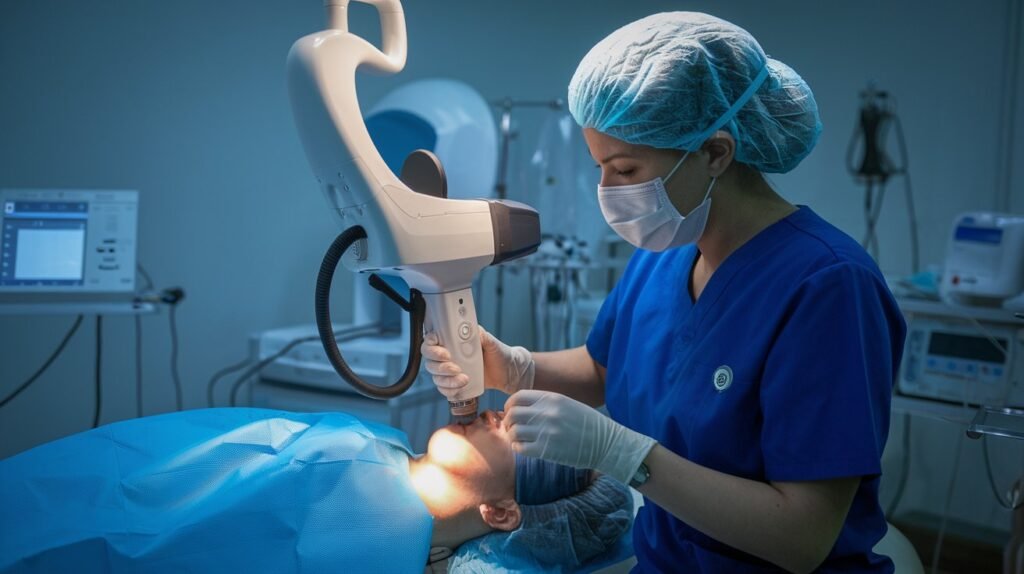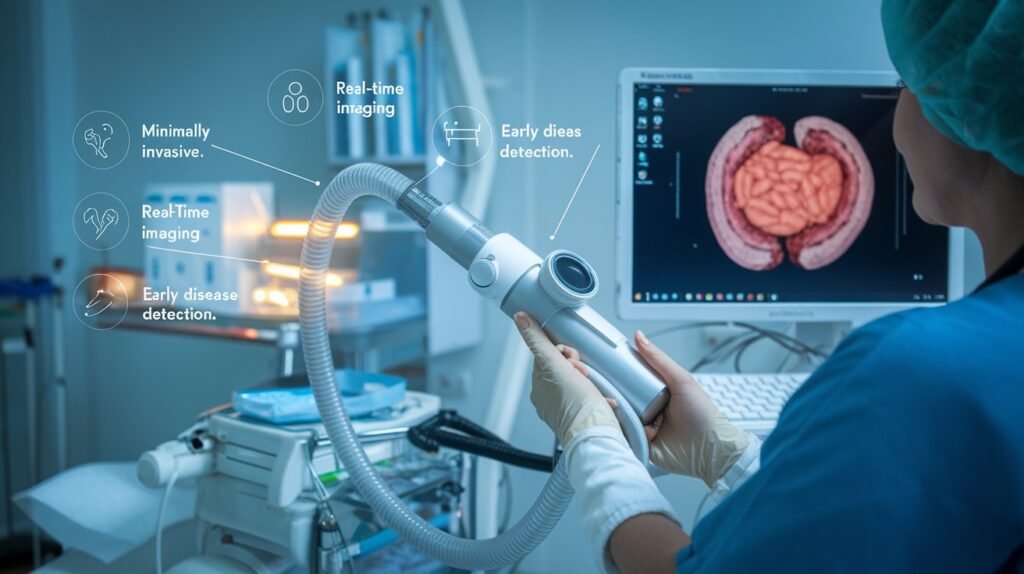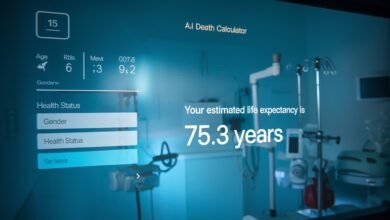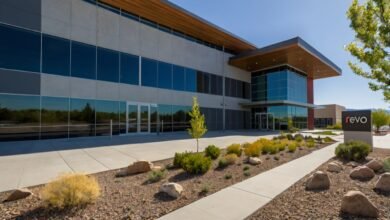A Glimpse Inside: Why Endoscopy Technology is the Future of Early Disease Detection
Endoscopy Technology
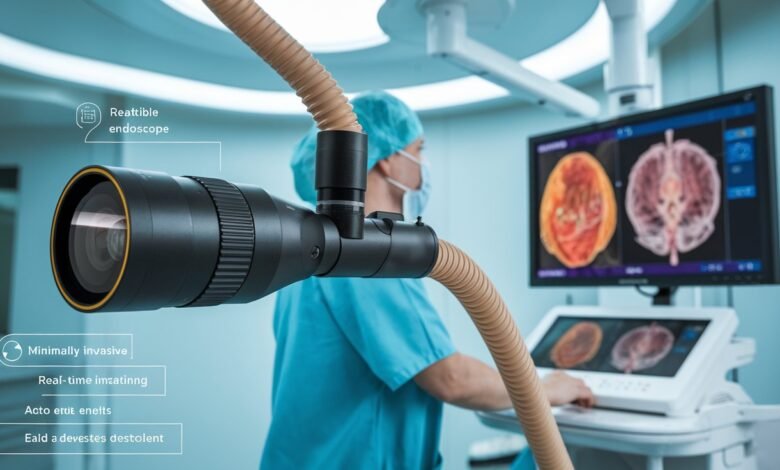
A Glimpse Inside: Why Endoscopy Technology is the Future of Early Disease Detection
Introduction:
Endoscopy technology has revolutionized the field of medicine, offering a minimally invasive approach to diagnosing and treating a wide range of conditions. At its core, endoscopy involves the use of an endoscope—a flexible tube equipped with a camera and light source—that allows healthcare professionals to examine the internal structures of the body visually. This technology enables physicians to identify abnormalities, perform biopsies, and even carry out therapeutic interventions with remarkable precision.
Early detection of disease is the most critical. Timely diagnosis significantly enhances the chances of successful treatment, particularly for conditions such as cancer, where the prognosis is often closely linked to the stage at which the disease is identified. Endoscopy technology plays a critical role in this context, providing real-time imaging that facilitates early intervention and reduces the need for more invasive surgical procedures.
In the modern landscape of medicine, early disease detection has become a pivotal focus. Research indicates that early diagnosis significantly increases the chances of successful treatment, particularly in diseases such as cancer. According to the World Health Organization, early detection can improve survival rates by up to 80%. With the advent of innovative medical technologies, the tools available to healthcare professionals have expanded dramatically. Among these, endoscopy technology stands out as a revolutionary approach to diagnosing and treating various conditions, especially cancers and gastrointestinal disorders. This article explores the multifaceted dimensions of endoscopy technology, its historical context, the diverse types of procedures it encompasses, its role in early detection, technological advancements, benefits, challenges, and future directions.
1. Understanding Endoscopy:
Definition of Endoscopy:
Endoscopy is a medical procedure that utilizes a flexible tube called an endoscope, equipped with a camera and light source, to visualize the internal structures of the body. The term “endoscopy” is derived from the Greek words “endon,” meaning “within,” and “skopein,” meaning “to look.” This procedure allows physicians to examine areas that are difficult to access through traditional surgical methods, making it invaluable for diagnosing a wide range of conditions.
Historical Evolution of Endoscopy Technology:
The origins of endoscopy can be traced back to the early 19th century when rudimentary instruments were developed to examine the human body. However, it wasn’t until the mid-20th century that significant advancements began to reshape the field. The introduction of fiber-optic technology in the 1950s allowed for enhanced illumination and clearer imaging, marking a turning point in endoscopic procedures.
Over the decades, endoscopy technology has evolved dramatically. The introduction of high-definition cameras and advanced imaging techniques has allowed healthcare providers to obtain remarkably detailed views of internal organs. This technological evolution has been accompanied by a growing understanding of the benefits of minimally invasive procedures, which offer faster recovery times and reduced complications compared to traditional surgical approaches.
Types of Endoscopic Procedures:
Endoscopy encompasses a variety of procedures tailored to specific areas of the body, each with its unique applications and significance. Understanding these different types helps illustrate the extensive applications of endoscopy technology:
- Gastroscopy (Upper Endoscopy): This procedure involves examining the esophagus, stomach, and duodenum (the first part of the small intestine). It is often useful for symptoms like chronic nausea and vomiting, abdominal pain, and dysphagia. Gastroscopy allows for direct visualization of the upper gastrointestinal tract and can facilitate biopsy and treatment of various conditions.
- Colonoscopy: Often regarded as one of the most critical procedures in preventive medicine, colonoscopy is crucial for screening colorectal cancer. During this procedure, a long, flexible tube is inserted into the rectum to examine the entire colon. It allows for the detection and removal of polyps, which are precursors to colorectal cancer and facilitates biopsy to diagnose potential malignancies.
- Bronchoscopy: This procedure allows doctors to see inside the airways and lungs. It is essential for diagnosing conditions such as lung infections, tumors, and chronic cough. Bronchoscopy can also involve therapeutic interventions, such as removing blockages or obtaining tissue samples for further analysis.
- Cystoscopy: This endoscopic procedure examines the bladder and urethra. It is often performed to investigate urinary tract issues, bladder infections, or abnormal growths. Cystoscopy can provide valuable insights into conditions affecting the lower urinary tract.
- Endoscopic Retrograde Cholangiopancreatography (ERCP): This specialized procedure combines endoscopy and X-ray imaging to examine the bile ducts and pancreas. It is commonly used to diagnose and treat conditions such as gallstones or bile duct obstructions, enabling timely interventions that can prevent serious complications.
Each type of endoscopic procedure plays a vital role in diagnosing various health issues, making early detection possible and effective.
2. The Role of Endoscopy in Early Disease Detection:
How Endoscopy Works:
The process of endoscopy typically begins with a comprehensive patient evaluation, which may include a medical history review and physical examination. Depending on the specific procedure, patients may be sedated or given local anesthesia to minimize discomfort. The endoscope is then inserted through a natural opening, such as the mouth or rectum, or, in some cases, through a small surgical incision.
As the endoscope navigates through the internal structures, high-resolution images are transmitted to a monitor, allowing healthcare providers to observe the tissues in real-time. This ability to visualize abnormalities immediately is one of the key advantages of endoscopy technology.
Real-Time Imaging and Its Benefits:
One of the most significant benefits of endoscopy technology is its capacity for real-time imaging. This capability allows healthcare providers to assess conditions as they happen, enabling timely intervention. For instance, during a colonoscopy, if a polyp is identified, it can be biopsied or removed immediately, thus reducing the risk of it developing into cancer. This immediacy not only enhances diagnostic accuracy but also significantly decreases the time between diagnosis and treatment, which is crucial in managing potentially life-threatening conditions.
Furthermore, real-time imaging helps facilitate better patient education. Patients can see their own scans and understand the nature of their conditions, fostering a more collaborative relationship between patients and healthcare providers. This will be highly effective in reducing anxiousness and compliance with treatment plans.
Types of Diseases Detected Early:
Endoscopy technology is instrumental in the early detection of various conditions, ranging from cancers to inflammatory diseases. The following highlights some of the key diseases that can be diagnosed early through endoscopy:
- Cancer: Endoscopy is particularly effective for detecting early-stage cancers of the esophagus, stomach, colon, and lungs. The ability to visualize and biopsy suspicious lesions increases the likelihood of catching malignancies before they progress to advanced stages. Studies have shown that early detection of cancers can lead to more effective treatment options and significantly improve survival rates.
- Inflammatory Diseases: Conditions such as Crohn’s disease, ulcerative colitis, and gastritis can be diagnosed early through endoscopic examination. Identifying these diseases in their early stages allows for timely management and intervention, which is crucial in preventing complications. For example, early treatment of inflammatory bowel disease can reduce the risk of surgery and improve a patient’s quality of life.
- Other Conditions: Beyond cancer and inflammatory diseases, endoscopy can help identify gastrointestinal bleeding, infections, and structural abnormalities. For example, esophageal varices, which are swollen veins in the esophagus that can bleed, can be detected and treated through endoscopy. The ability to identify these conditions early can significantly impact patient outcomes and quality of life.
3. Technological Advancements in Endoscopy:
Innovations in Endoscopic Technology:
The landscape of endoscopy technology is continually evolving, driven by the need for more effective diagnostic tools. Key innovations include:
- High-Definition Imaging: Modern endoscopes are equipped with high-definition cameras that provide superior image quality, enhancing the clarity and detail of internal examinations. High-definition imaging is particularly beneficial in identifying subtle lesions that may be overlooked in standard imaging.
- Narrow-Band Imaging (NBI): This specialized technique improves the contrast of vascular structures and mucosal surfaces, making it easier for physicians to identify abnormal lesions during procedures. NBI enhances the diagnostic capabilities of endoscopy technology, particularly in detecting early-stage cancers.
- Digital Documentation: The integration of digital documentation systems allows for real-time storage and analysis of images and data collected during endoscopic procedures. This capability enhances communication between healthcare providers and facilitates more effective treatment planning.
Integration of AI and Machine Learning:
Artificial intelligence (AI) is beginning to transform endoscopy technology. AI algorithms can analyze images in real-time, assisting physicians in identifying polyps, lesions, or early signs of cancer. Research indicates that AI-assisted endoscopy can significantly improve detection rates, ensuring that more patients receive timely diagnoses.
For instance, machine learning models can be trained on large datasets of endoscopic images to recognize patterns indicative of specific conditions. By augmenting the capabilities of trained professionals, AI has the potential to reduce diagnostic errors and enhance overall patient care. A study published in a leading medical journal found that AI algorithms could detect colorectal cancer with greater accuracy than experienced endoscopists, showcasing the promising future of this technology.
Robotic-Assisted Endoscopy:
The advent of robotic-assisted endoscopy represents another exciting development in the field. Robotic systems provide enhanced precision and control during procedures, making them less invasive and improving patient comfort. These systems facilitate better maneuverability in hard-to-reach areas of the body, allowing healthcare providers to perform complex interventions with greater accuracy.
Robotic-assisted endoscopy is particularly beneficial in delicate procedures where precision is paramount, such as in the removal of tumors or biopsies in confined spaces. The use of robotic assistance can also reduce the physical strain on healthcare providers, allowing them to perform procedures with greater endurance and less fatigue.
4. Benefits of Early Detection Through Endoscopy:
Improved Patient Outcomes;
The benefits of early detection via endoscopy technology are manifold, with improved patient outcomes being one of the most significant. Numerous case studies illustrate how early intervention can lead to successful treatment and better survival rates. For example, patients diagnosed with colorectal cancer at an early stage typically have a much higher five-year survival rate compared to those diagnosed at later stages.
The immediate detection of precancerous lesions, such as adenomatous polyps, during colonoscopy, can prevent the development of colorectal cancer altogether. This proactive approach not only saves lives but also alleviates the emotional burden associated with cancer diagnoses.
Impact on Survival Rates and Treatment Options:
When diseases are detected early, patients often have access to a wider array of treatment options. Early-stage cancers may be treatable with less aggressive therapies, such as localized radiation or minimally invasive surgical techniques. This not only preserves the patient’s quality of life but also reduces the risk of severe complications associated with more advanced disease stages.
Moreover, early detection can prevent the need for extensive treatments, which can be physically and emotionally taxing for patients. The earlier a condition is diagnosed, the more choices patients have, empowering them to make informed decisions about their care.
Cost-Effectiveness:
Investing in early detection through endoscopy technology can lead to substantial cost savings in healthcare. Treating advanced diseases typically incurs higher costs due to prolonged hospital stays, aggressive treatments, and complications. Early diagnosis can mitigate these expenses by enabling simpler, less costly treatments and shorter recovery periods.
Healthcare systems that prioritize early detection and intervention can not only improve patient outcomes but also enhance their economic efficiency. A comprehensive study found that investing in preventive screening programs, including colonoscopy, could save the healthcare system billions in treatment costs for late-stage cancers.
5. Challenges and Considerations:
Limitations of Current Endoscopy Practices:
Despite its many advantages, endoscopy technology is not without limitations. Some potential risks associated with endoscopic procedures include:
- Complications: Major complications are rare and very seldom unless under rather little warning. Risks include bleeding, infection, or perforation of the organ being examined. Patients must be informed of these risks during the consent process to make informed decisions about their care.
- Patient Discomfort: Many patients experience discomfort during endoscopic procedures, particularly those that involve sedation or require the endoscope to navigate sensitive areas. While sedation is often used to alleviate discomfort, it does add complexity to the procedure and may require additional monitoring.
- Training and Expertise: The effectiveness of endoscopy technology is heavily reliant on the skill and expertise of the healthcare providers performing the procedures. Continuous training and professional development are essential to ensure that practitioners are well-equipped to utilize the latest advancements in endoscopy technology.
Accessibility and Patient Awareness Issues:
Access to endoscopic procedures can vary significantly based on geography, insurance coverage, and patient awareness. Many people may be unaware of the importance of screenings or hesitant to undergo these procedures due to fear or misinformation. Educational campaigns are essential to raise awareness about the role of endoscopy technology in disease detection.
Moreover, disparities in healthcare access can lead to inequities in early disease detection. Addressing these disparities requires targeted outreach and education efforts, particularly in underserved communities. Public health initiatives that promote awareness of screening guidelines can play a crucial role in encouraging individuals to seek timely evaluations.
Future Directions:
The future of endoscopy technology holds great promise, with ongoing research and development focused on improving existing techniques and introducing new innovations. Key areas of exploration include:
- Capsule Endoscopy: This technique involves using a small, swallowable camera to capture images of the gastrointestinal tract as it passes through the body. It is particularly beneficial for patients with suspected small bowel disorders and those who may be unable to undergo traditional endoscopic procedures. Its noninvasive nature makes it an appealing option for many patients.
- Telemedicine Integration: The rise of telemedicine has the potential to enhance access to endoscopic evaluations. Remote consultations can help bridge the gap for patients in rural or underserved areas, ensuring they receive timely referrals and follow-up care. Telehealth platforms can facilitate pre-procedure assessments and post-procedure follow-ups, improving overall patient satisfaction and outcomes.
- Personalized Medicine: Advances in genomics and molecular biology may enable the development of personalized approaches to disease prevention and treatment. By integrating genetic information with endoscopic findings, healthcare providers could tailor screening and treatment strategies to individual patients. This personalized approach could significantly enhance the effectiveness of interventions and improve patient outcomes.
6. Conclusion:
In conclusion, endoscopy technology is rapidly emerging as a cornerstone of early disease detection in modern medicine. Its ability to provide real-time imaging, combined with technological advancements like AI and robotic assistance, has transformed how healthcare providers diagnose and treat conditions. Early detection not only improves patient outcomes and survival rates but also offers a cost-effective approach to managing diseases.
As we look to the future, it’s essential to continue raising awareness about the importance of endoscopic screenings and advocating for broader access to these life-saving technologies. By embracing these advances, we will be able to improve early detection and save more lives.
Additional Resources:
For those interested in exploring more about endoscopy technology and its impact on healthcare, consider the following resources:
- World Health Organization on Early Disease Detection
- American Society for Gastrointestinal Endoscopy
- National Cancer Institute on Screening Tests
- American College of Gastroenterology
If you have specific questions or wish to find local healthcare services offering endoscopic procedures, consult your primary care provider or visit health services websites to learn more about available options.

